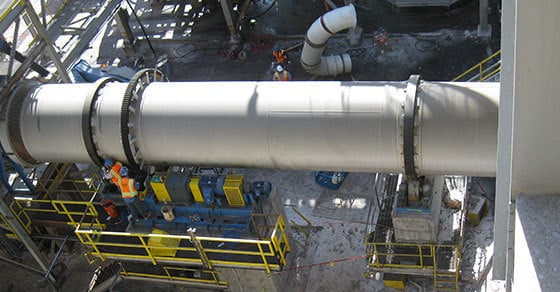Variable Frequency Drives, or VFDs, are not a new technology, but only in recent decades have advancements in the field lowered many of the barriers associated with widespread VFD use, allowing their application in a range of settings.
A recent market study anticipates that the VFD market will reach a value of USD 37.4 billion by 2027, growing annually at a rate of 6.5%. As energy efficiency becomes a greater focus in managing industrial processes, producers looking for ways to optimize their process will increasingly turn toward VFDs. What many don’t realize is that there are several other advantages to using a VFD. As a leader in process design and development, FEECO recommends customers take advantage of the many benefits a VFD can offer equipment of all types.
What is a Variable Frequency Drive (VFD)?
A traditional fixed-speed AC motor has one speed. This means that the unit starts, runs, and stops at the same speed; it is either on or off, with no in-between. In contrast, a variable frequency drive, also known as a variable speed drive (VSD) or adjustable frequency drive (AFD), gives operators the ability to precisely adjust motor speed.
VFDs can be used to control many different types of process equipment. Equipment may require a VFD for proper operation, or it may be preferred as an upgrade for the many reasons explained below, depending on the type of equipment and the chosen manufacturer.
Why use a VFD?
Worldwide, VFDs are being implemented to maximize energy efficiency, with the potential to reap large gains from small improvements. While energy efficiency is an added benefit when utilized with FEECO equipment, perhaps more importantly, is that the VFD allows operators to influence process parameters.
The potential for energy savings is significant in itself, but there are many other possible advantages to utilizing a VFD as well. Processors will often implement VFDs on FEECO equipment to achieve the following objectives:
To Reduce Power Surges at Start-Up
On start-up, a fixed-speed AC motor consumes several times as much energy as the motor’s full load. This has several implications:
- Significant mechanical shock
- Increased motor wear (the increased load creates heat and over time, wears down the motor)
- Surges in consumed power
Through the use of a VFD, motor speed is gradually increased at a controlled rate to the desired speed during start-up, eliminating mechanical shock and reducing motor wear, while also avoiding power surges. Depending on the motor size, a VFD may be more economical than traditional soft start mechanical devices such as fluid couplings.
As with a gradual start-up, the controlled shutdown provided by a VFD is also beneficial in minimizing mechanical shock.
To Fine-Tune a Process
VFDs are also useful in fine-tuning a process during start-up. Reaching the desired product specifications is often not instantaneous with exactly known process equipment speeds. The ability to carefully control motor speeds during start-up gives operators more precision in finessing the process to reach the desired output.
Especially in agglomeration, accurate raw material feed rates are critical in creating a consistent product. VFDs are essential in controlling feed rates and providing a repeatable setpoint for various product formulations. This approach is commonly employed in pelletizing lines utilizing pin mixers and disc pelletizers.
To Protect Equipment With a Torque Limit
When equipment becomes jammed or clogged, fixed-speed AC motors are prone to overloading and causing mechanical damage. By using a VFD, a torque limit can be set so that the motor will stop upon reaching the allowable limit, preventing any damage.
When Process Conditions Change
A VFD also allows operators to adjust speed in response to changes in production, promoting more fluid operation less susceptible to process upsets during times of fluctuation.
To Control Retention Time
It is often desirable to adjust retention or residence time in process equipment for various reasons. When using a fixed-speed electric motor, retention time must be controlled through less favorable approaches such as mechanically altering equipment, but with a VFD, operators have the ability to directly affect retention time with the push of a button. This is a common technique used with pugmill mixers and granulators.
To Improve Accessibility for Maintenance
In some cases, a VFD is also useful for maintenance. This is often seen with bucket elevators and rotary drums, where specific mechanical components can be positioned appropriately for access. A VFD allows operators to slowly rotate equipment for proper maintenance positioning.
To Reduce Sticking and Buildup
In some settings, particularly when working with rotary kilns, material sticking and buildup inside the processing device may be averted by adjusting the rotational speed of the unit. A higher rotational speed helps to prevent incoming sticky material from being able to stick to the drum shell. With drums utilizing internal agitators such as chains, the higher speed also encourages more aggressive agitation, further contributing to a reduction in buildup and sticking. This type of adjustment is made possible with the help of a VFD.
Conclusion
As energy efficiency becomes an ever-greater focus in industry, VFDs will continue to offer producers a way to achieve their energy efficiency goals, but VFDs provide so much more than just a savings in energy; they give operators more control over the process and provide a means of fine-tuning the process based on changes in production.
FEECO serves the global industrial processing industries with a wide range of custom equipment, including rotary dryers and coolers, rotary kilns and calciners, pin mixers, pugmill mixers, and disc pelletizers, as well as a comprehensive line of material handling equipment. All FEECO equipment is amenable to VFD control to increase process control and maximize energy savings. For more information on our equipment, contact us today!

